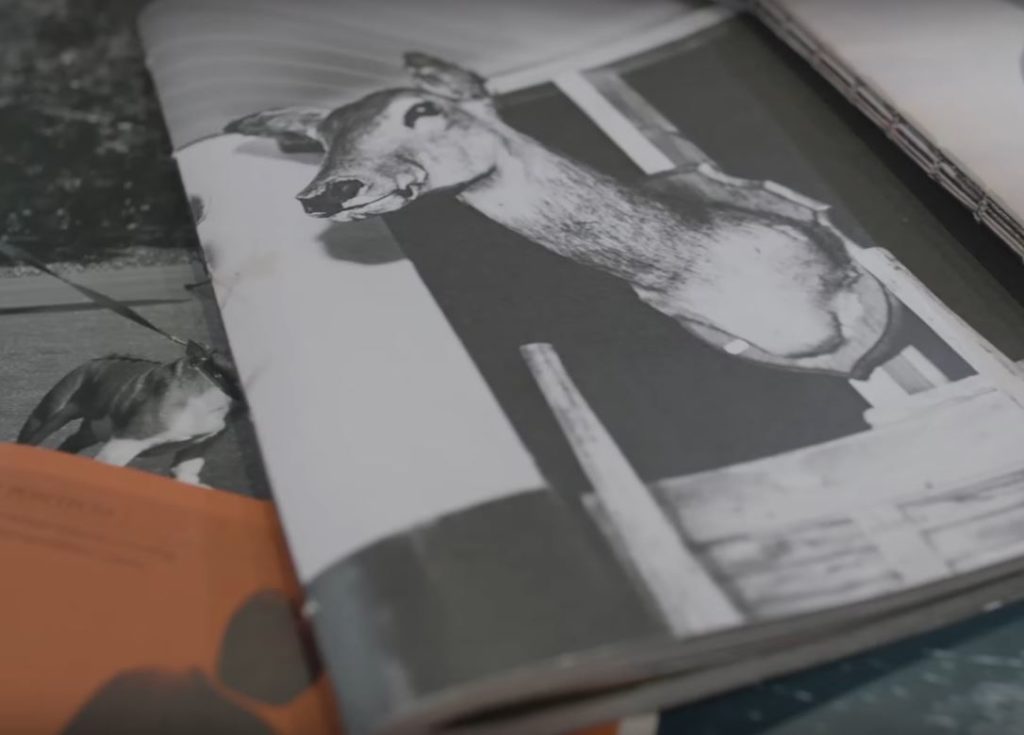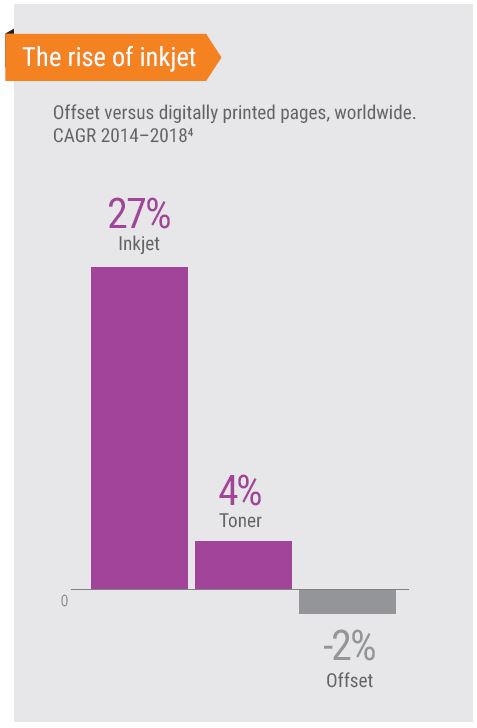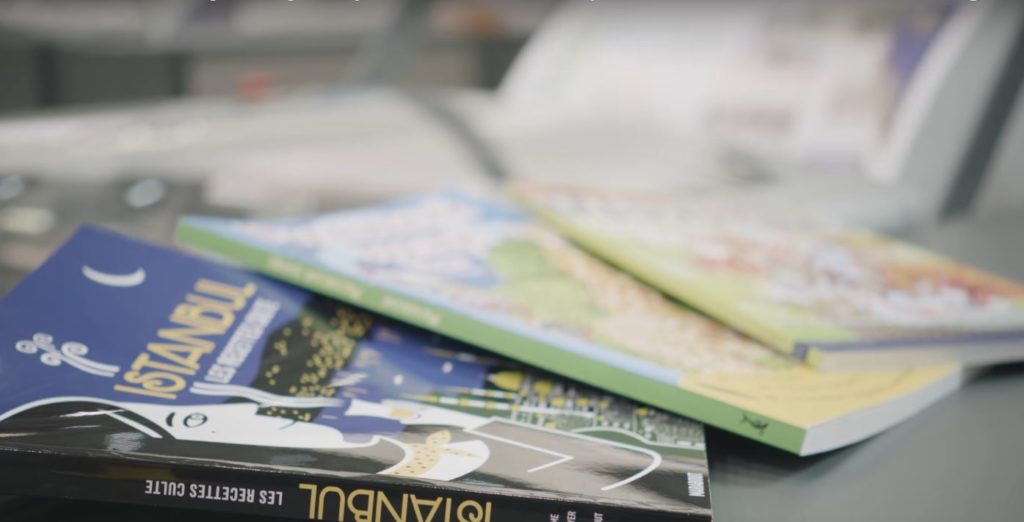For the last few years, many trade book publishers have improved their inventory control by meeting more short-term demand with production monochrome inkjet printing. Longer runs continue to be the province of offset presses, but inkjet is fulfilling the long-held promise of short-run, print on demand by delivering the fastest print speeds, lowest operating costs, faster turnarounds and the highest capacities available in digital printing.
Four-color inkjet technology , however, has yet to deliver this same value proposition for trade books and other book segments where color is dominant. As a result, long offset runs continue to monopolize production of color books—children’s books, higher education and K-12 textbooks, and adult trade books, such as how-to books and cookbooks. This is unfortunate, because two circumstances make the need to quickly fulfill short orders especially urgent for many color book titles.
, however, has yet to deliver this same value proposition for trade books and other book segments where color is dominant. As a result, long offset runs continue to monopolize production of color books—children’s books, higher education and K-12 textbooks, and adult trade books, such as how-to books and cookbooks. This is unfortunate, because two circumstances make the need to quickly fulfill short orders especially urgent for many color book titles.
One is that, for decades, a significant number of color trade books and children’s books have been printed “off shore”, where production costs are so much lower than those in the US or Western Europe that publishers willingly accept lead times that typically stretch to several weeks.
The other factor is that many of these titles have narrow sales windows. As an example, cook books are big Mother’s Day and Christmas gifts; Children’s books sell at Easter and Christmas; and English-language higher education titles sell at the beginning of the academic semester.

Together, these circumstances put pressure on publishers to ensure that the preliminary print runs they order fully cover their narrow window of opportunity, because one thing is clear: if supplies run out, the overseas pipeline cannot refill the channel fast enough to save the sales. To mitigate this risk, publishers typically order volumes at the higher end of their sales projections. More often than not, this creates the same inventory challenges which mono trade book publishers have faced and are now solving with mono production inkjet technologies, resulting in improved inventory turns and better cash flow.
Clearly, an effective and economic four-color digital print model could attack this issue in the publishing supply chain. Color inkjet has the speed and capacity to efficiently produce runs of one to 1,000 units—enough to alter the supply chain model—but its impact has been limited due to image quality issues and the relatively high cost of the coated stocks required by most color inkjet presses.
That will soon change. Later this year, Xerox will release new High Fusion Inks on its Trivor 2400 platform which enable high-quality color inkjet printing on untreated commodity offset coated stocks with no pre- or post-print coatings. These stocks often cost 15 to 20 percent less than specialty inkjet treated stocks and can help providers standardize on fewer paper stocks to better manage costs.
Those advancements alone don’t make color inkjet printing cost-competitive with offshoring. But when you factor in the elimination of offshoring’s freight, administrative and handling costs; the savings from more tightly managing the supply chain to eliminate waste; and the additional revenue generated from having 48-hour turn times on reorders, you begin to see the potential for a winning business model.
https://youtu.be/-uG56r2LNNs?list=PLioPSVdbzdpZHN7MyCsEnX76Y18cS-34X
Publishers want to solve this problem, and many are eager to investigate color inkjet’s potential. That’s why leading publishers are taking part in a two-day event at Hunkeler Innovationdays to discuss this challenge and the potential for color inkjet to solve it. The publishers—Harper Collins, Hachette Book Group and Pearson—will discuss these issues with over 60 European print providers interested in the opportunity.
And it’s a significant opportunity, in the ballpark of $60 million annually for Europe alone comprising pages that are new to the region, and supporting a feel-good story that manufacturing is returning to the homeland.
 To learn more about Xerox digital book production, click here.
To learn more about Xerox digital book production, click here.Interested in participating in the movement to onshore digital color book printing? Connect with me on LinkedIn and I’ll be happy to discuss.




This is a huge opportunity for PSP’s looking to enhance relevance in the industry and bring more value to clients.
Good Article…
Brian Ruiz
Xerox Corporation
Program Manager
Production Printing, Software, Technology, and Business Development Consulting
Brian.Ruiz@xerox.com
(714) 310-8684
Connect With Me, and i can provide you no cost resources to help grow your business:
http://www.LinkedIn.com/in/BrianRuiz
http://www.TheBrianRuiz.com
The ink seems to be the game changer being able to print with the new High Fusion Inks on your Trivor 2400 platform which enable high-quality color inkjet printing on untreated commodity offset coated stocks with no pre- or post-print coatings. I like to learn more about high fusion inks. Great job presenting this new innovation Mr. Conely.
Thomas,
Thank you for your comments. The High Fusion inks have been in development for a few years. Xerox showed it as a demonstration technology at Drupa last spring and ran the updated ink sets at Hunkeler Innovation Days in Lucerne this past February. The ink set is targeted for use initially with our Trivor 2400 press platform which we released at Drupa last June. As we approach the Print show in Chicago this fall we will be able to offer much more detailed information on the operational characteristics of the new HF inks.
Regards,
John